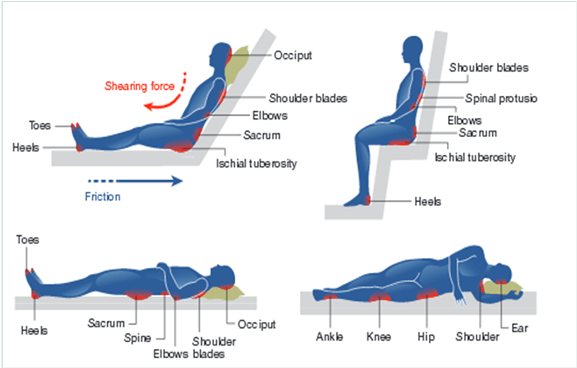A Resident and Family Guide to Preventing Pressure Injuries
Pressure Injury is damage which has occurred to the skin as a result of unrelieved pressure. The damage may appear as a red area, blister (or purple or blood-filled area), or open wound. The area may be warmer, swollen or painful if you can feel this.
Pressure injuries can develop quickly. They can be difficult to heal, cause pain, infection and even death. Most pressure injuries are preventable. Skin safety is important.
Locations of Pressure Points

Who are the residents who may be at risk?
- Limited movement or those unable to move independently
- Confined to wheelchairs or bed
- Have poor appetite, poor circulation, weight loss or severe illness
- Have reduced feeling or sensation (such as people with diabetes or spinal cord injuries)
- Skin that is frequently moist through sweat or loss of bowel/bladder control
- Are near the end of life
What Can You Expect From Us?
Assessment: Your skin will be assessed on admission and regularly for changes.
Surface: A mattress and cushion will be provided depending on your level of risk and skin condition.
Keep Moving: Assistance with repositioning using correct equipment (for example sliding sheets) will be provided for immobile patients.
Incontinence: Will be assessed and skin kept clean and moisturized.
Nutrition: Will be assessed and assistance to eat and drink may be provided. Supplements and snacks offered and a referral to a dietitian may be made if you are identified as at risk.
If you have an existing pressure injury: a care plan will be developed for you and referrals may be made to assist in your care.
Tips For Prevention of Pressure Injuries
- Remove the source of pressure.
- Change position often (3 times an hour when sitting and every 2 hours when in bed).
- Keep moving as much as you possibly can
- Avoid sliding and dragging self when transferring out of chairs and bed.
- Residents in wheelchairs should have the Occupational Therapist conduct a seating assessment (you may need special cushions).
- Use pillows between legs, and heal protectors to relieve pressure.
- Use a pillow lengthwise from heel to knee to lift heel off bed to reduce pressure.
- Do not sit on the sling for mechanical lifts.
- Frequently apply moisturizer to skin.
- Drink plenty of fluids.
- Walk as much as possible. We encourage a range of motion exercises.
- Do not massage any boney areas of the body that have reddened.
- Have a dietician review diet and supplement as needed.
- Inspect skin once daily.
- Manage moisture with incontinent system.
- Maintain head of bed below 30 degrees and raise knees slightly to limit sliding.
- Cover skin to protect from friction, when possible, for example: wear socks
- Residents with darker tone skin are more likely in comparison with light skin tones to develop more severe pressure injuries
- Everybody is different and some statements may not apply in your situation. It is important to speak with your health care professional about your individual needs
Contact
Shoreham Village Home for Special Care
50 Shoreham Village Crescent
Chester, NS, B0J 1J0
(902) 275-5631

